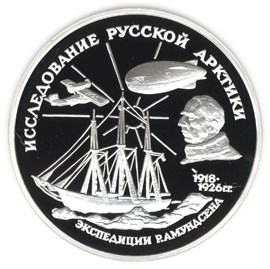R. Amundsen
Obverse
in the center — the Emblem of the Bank of Russia (the two-headed eagle designed by I.Bilibin), the letters under it indicate the metal sign, the fineness, the mint trademark and the fine metal content. The inscriptions along the rim framed by a circle of dots : at the top — «3 РУБЛЯ 1995 г.» (3 RUBLES 1995), at the bottom — «БАНК РОССИИ» (BANK OF RUSSIA) ,
Reverse
at the top to the left - an airplane, to the right - a dirigible, in the centre - an ice-bound sailing ship, to the right of the ship - a portrait of Roald Amundsen, below - two dates "1918 * 1926 гг.". The inscriptions along the rim: at the top — «ИССЛЕДОВАНИЕ РУССКОЙ АРКТИКИ" (EXPLORATION OF RUSSIAN ARCTIC), at the bottom - " ЭКСПЕДИЦИЯ Р. АМУНДСЕНА" (THE AMUNDSEN EXPEDITION).
Authors
The artist: A.V. Baklanov
The sculptor: I.S. Komshilov
Moscow Mint (ММД)
The edge: 300 corrugations
The Arctic, or the Northern polar part of the Earth, has attracted courageous seafarers and naturalists from time immemorial, but its intense exploration began in the late nineteenth century. Important oceanological observations were made by Fridtjof Nansen's expedition of Norwegian North Pole explorers on the sailing ship Fram (1893-1896) and the expedition of Roald Amundsen on the ship Mod (1918-1920). In 1926 the latter directed the first ever flight from Spitsbergen to America via the North Pole on the dirigible Norway. The commander of the airship was the Italian engineer Umberto Nobile. In 1928 Nobile led the Italian expedition to the North Pole on the dirigible Italia, which broke and crashed. The Russian icebreaker Krasin took part in the expedition to rescue Nobile and his team. In 1933 the Russians made an attempt to sail from Murmansk to Vladivostok along the North Sea Route within one navigation period on board the steamship Chelyuskin (named after the 18th-century Russian North Pole explorer Semyon Chelyuskin), but in February 1934 the ship was crushed by the ice in the Chuckchee Sea and the participants in the expedition were rescued by aircraft. In 1937 Russia set up the first drifting research station, North Pole-1, in the North Pole, on which Ivan Papanin, Yevgeny Fedorov, Petr Shirshov and Ernst Krenkel worked. In 1937 Russian pilots Valery Chkalov, Georgy Baidukov and Alexander Belyakov made a non-stop flight from Moscow to Vancouver through the North Pole.


